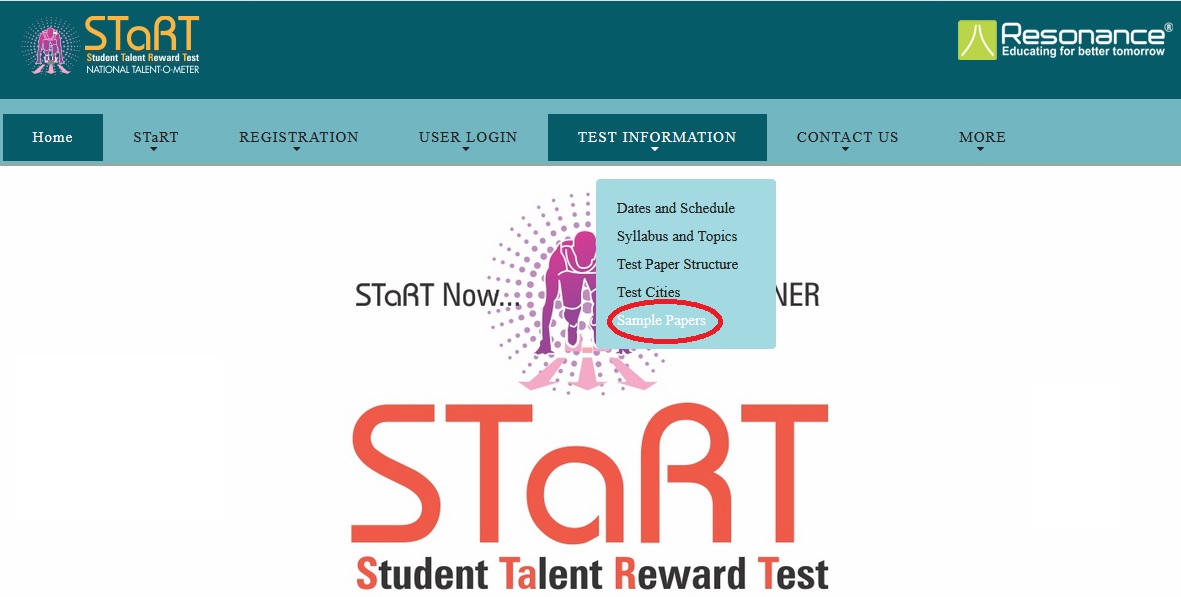Resonance STaRT 2018 Sample Paper of Class VI : Student Talent Reward Test
Name of the Organization : Resonance Eduventures Limited
Name of the Exam : Student Talent Reward Test – STaRT
Document Type : Sample Test Paper
Year : 2018
Class : VI
Website : https://www.resostart.in/
RESO STaRT Class VI Sample Paper
Download the Sample Test Paper of Student Talent Reward Test – STaRT for class VI from the official website of Resonance Eduventures Limited.
Related : ResoSTaRT Sample Paper Class VII 2018 : www.pdfquestion.in/34847.html

Physics
1. Which one of the following is the nearest planet to the sun ?
(A) Mercury
(B) Earth
(C) Mars
(D) Jupiter
2. See- Saw is an example of –
(A) Inclined Plane
(B) Lever of I order
(C) Lever of III order
(D) None
3. The shape of our Galaxy is
(A) Elliptical
(B) Circular
(C) Serpentine
(D) hyperobolic
4. Which of the following part of planets can not be seen through neked eyes ?
(A) Uranus & neptune
(B) Saturn & Uranus
(C) Mercury & Uranus
(D) Mercury & Venus
5. The minimum time to complete one revolution around the sun is taken by
(A) Earth
(B) Mercury
(C) Pluto
(D) Jupiter
6. The proper care and maintance of machines require
(A) To make them good woking
(B) For preserving them for future
(C) For good looking
(D) None of these
7. The names of the planets in order of increasing distances from the sun are
(A) earth, jupiter, mars
(B) jupiter, mars, earth
(C) jupiter, earth, mars
(D) earth, mars, jupiter
8. On a full moon day, the –
(A) moon lies in between the Earth and the Sun.
(B) Earth lies in between the moon and the Sun.
(C) Sun lies in between the Earth and the moon.
(D) can’t say
9. What is an inclined plane wrapped around a cylinder ?
(A) Scissor
(B) Screw
(C) Wedge
(D) Wheel and axle
10. How long does the Earth take to make one complete revolution around the Sun ?
(A) 24 hours(?k.Vs)
(B) 28 hours(?k.Vs)
(C) 240 days(fnu)
(D) 365 days(fnu)

Biology
11. Plant whose flower and fruit both are eaten
(A) Sugar beet
(B) Ginger
(C) Sugarcane
(D) Banana
12. ………………….can be given to a patient to recover from dehydration.
(A) proteins
(B) carbohydrates
(C) fats
(D) ORS
13. Vegetables and fruits are rich sources of
(A) proteins, carbohydrates and fats
(B) carbohydrates, fats and minerals
(C) vitamins, minerals and roughages
(D) starch, roughages and minerals
14. Process of loss water through stomata is called
(A) Translocation
(B) Transpiration
(C) Photosynthesis
(D) Transportation
15. A non-green plant
(A) Mould
(B) Cactus
(C) Sugarcane
(D) Algae
16. Plants take in and give out gases through
(A) their roots
(B) their stems
(C) microscopic pores ontheir leaves
(D) special organs
17. Fixed joint is found in
(A) cranium
(B) knee
(C) fingers
(D) elbow
18. The hard, protective covering on the stems of some plants is called
(A) trunk
(B) bark
(C) axil
(D) bud
19. An animal that has the ability to camouflage.
(A) Rat
(B) Elephant
(C) Stick insect
(D) All of the above
20. Small plants which live for one or two seasons are
(A) herbs
(B) shrubs
(C) trees
(D) algae
Download Class VI Sample Paper :
https://www.pdfquestion.in/uploads/pdf2019/34844-VI.pdf
Chemistry
21. Examples of natural fibres are
(A) nylon and rayon
(B) nylon and cotton
(C) rayon and silk
(D) silk and cotton
22. Wool is obtained from
(A) hair of bear.
(B) hair of yak.
(C) worm.
(D) hair of monkey.
23. Mixture of salt and iron powder is separated by
(A) hand picking.
(B) magnetic separation.
(C) sieving.
(D) churning.
24. Handpicking method can be used for separating mixture of
(A) sugar powder and salt.
(B) red and blue coloured balls of same size.
(C) oil and water.
(D) milk and cream.
25. Conversion of water into vapours occurs at
(A) 80 degree centigrade
(B) 150 degree centigrade
(C) 0 degree centigrade
(D) 100 degree centigrade
26. The method of sieving is used to separate a mixture containing
(A) butter and cream
(B) flour and sugar
(C) coins of different sizes
(D) salt dissolved in water
27. Kerosene or edible oil do not dissolve in water. They are called-
(A) Immiscible liquids
(B) Liquid solvents
(C) Liquid solutes
(D) Miscible liquids
28. Which of the following is insoluble in water
(A) chalk powder
(B) sand
(C) both (A) & (B)
(D) sugar
29. The paper used in the process of filtration to separate a mixture of sand and water is
(A) butter paper.
(B) plain paper.
(C) tissue paper.
(D) filter paper.
30. The part of the jute plant from where jute fibre is obtained is
(A) leave.
(B) root.
(C) stem.
(D) flower.